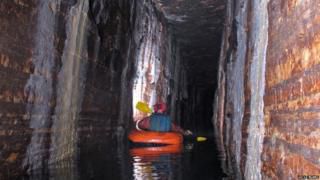
 Image copyright
Image copyrightLuc Le Blanc / Société québécoise de spéléologie
Amateur explorers have discovered a network of 15,000-year-old caves underneath a Canadian city.
The passageway, which is at least 200 metres long (660ft), was formed during the last ice age underneath what is now the city of Montreal.
The "once in a lifetime" October find by Luc Le Blanc and Daniel Caron was the result of years of trial and error.
Connected to the Saint-Léonard Cavern, the cave network is six metres deep and parts must be traversed by boat.
Image copyright
Guillaume Pelletier / Société québécoise de spéléo
For years, Mr Le Blanc and Mr Caron, both members of the Quebec Speleological Society, believed there must be another set of caves connected to Saint-Léonard Cavern near Parc Pie XII in the Saint-Léonard neighbourhood of Montreal, but they did not know exactly where.
Then in 2014, the pair got their first inkling of what might be underneath when dowsing rods - a wooden rod commonly used to find groundwater - found a small fissure in the ground.
Image copyright
Luc Le Blanc / Société québécoise de spéléologie
The fissure was too small to explore, but it gave them hope. A year later, they attached a camera to the rod and got their first glimpse inside the caves.
"You could see there was something, there was more cave beyond that fissure," Mr Le Blanc told the BBC.
More like this:But it would take two years before the pair found a part of the ground soft enough to dig into. Like the Saint-Léonard Cavern, these tectonic passageways were formed during the last ice age from the pressure of the glacier above. The weight of the ice weakened the passageway's limestone ceiling and Mr Le Blanc and Mr Caron were eventually able to break through.
Image copyright
Luc Le Blanc
"With just a regular hammer drill and chisel and hammer we were able to open an opening that was big enough so that we could see beyond the end of the fissure," he said.
But their ordeal was not over. After putting a latter into the opening, which dropped down about three metres, the pair began to explore.
They soon hit a wall of rock and debris that they had to traverse on rope.
Once they crossed the wall, the passageway began to slope down and they hit the aquifer. Further into the passageway, the ceiling was so low and the water so deep that they had to turn around and come back - this time armed with an inflatable boat.
Image copyright
Daniel Caron / Société québécoise de spéléologie
So far, they've explored about 150 metres of the passageway, all while doing precise surveying for the city to make sure no homes above ground are affected by the cave.
They are waiting for winter, when the water table gets lower, to explore the rest of the caverns, which they think go on for at least another 50 metres.
"We still have more exploring to do," he said.
"For us it's a major discovery, the kind of discovery you make once in a lifetime."
Source link
Read the full article

